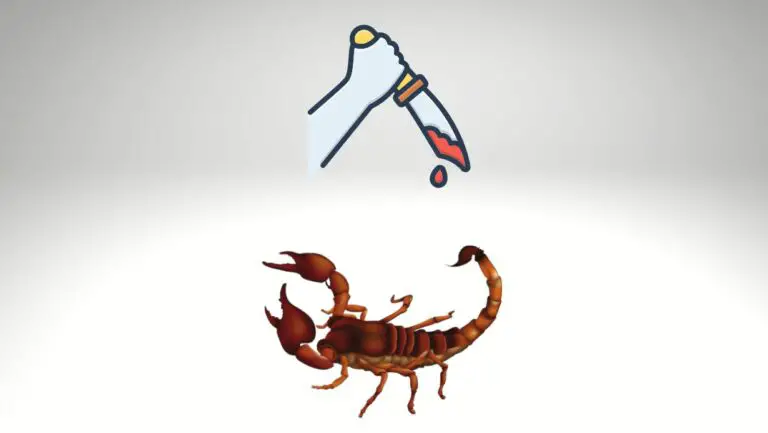
- Pectines: Pectines are comb-like structures located on the underside of a scorpion’s abdomen. In males, pectines are typically longer and thicker compared to females. However, this method of sex determination requires a close examination and is more reliable in mature scorpions.
- Metasoma (tail) shape: Male scorpions often have a thinner, more elongated metasoma (tail) compared to females. Females may have a broader, more rounded metasoma, especially when they are carrying embryos.
- Observing behavior: During mating season, male scorpions are typically more active and can be seen searching for females. Females may display defensive behavior if they are protecting young or their territory.
- Size differences: In some scorpion species, males are smaller in size compared to females. However, this can vary depending on the species, so it is not a definitive method of sex determination.
- Behavioral observations: During mating season, male scorpions are typically more active and may engage in courtship behaviors to attract females. Females may display defensive behavior if they are protecting their young or territory.
How to Identify the Gender of a Scorpion? 10 Ways
Identifying the gender of a scorpion can be challenging, but here are 10 general ways that can help you determine the sex of a scorpion:
- Pectines: Examine the pectines, which are comb-like structures on the ventral side of the scorpion’s abdomen. In general, males have longer and thicker pectines compared to females. However, this method requires close inspection and may be more reliable in mature scorpions.
- Metasoma shape: Observe the shape of the metasoma (tail). Male scorpions often have a thinner and more elongated metasoma, while females may have a broader and more rounded metasoma, especially when carrying embryos.
- Body size: In some scorpion species, males are smaller in size compared to females. However, this size difference can vary among species, so it is not always a definitive indicator.
- Chela size and shape: The chela refers to the pincers or claws of the scorpion. Male scorpions generally have larger and more robust chelae compared to females. This difference is more pronounced in some species than others.
- Behavioral differences: Observe the behavior of the scorpions, particularly during the mating season. Males are often more active, roaming in search of females, while females may display defensive behavior if they are protecting young or their territory.
- Courtship behavior: Watch for courtship rituals where males engage in specific behaviors to attract females. These behaviors can vary among scorpion species but may involve dance-like movements or gentle tapping with the chelae.
- Spermatophore presence: In some species, males create a spermatophore, a structure containing their sperm, which they deposit for the female to pick up during mating. The presence of a spermatophore can indicate the male’s gender.
- Observation of mating: If you witness scorpions mating, it is a clear indication of their respective genders. Males typically mount the females from behind during the mating process.
- Embryo carrying: Female scorpions that are carrying embryos on their back are unmistakably females. The presence of embryos indicates their gender.
- Expert consultation: If you are uncertain about the sex of a scorpion or need accurate identification, it is advisable to seek guidance from knowledgeable experts, such as experienced scorpion breeders, entomologists, or arachnologists.
Remember that accurately identifying the gender of a scorpion can be challenging, and it requires expertise, species-specific knowledge, and close observation. Not all methods are applicable to every species, so it’s best to rely on a combination of factors and consult with experts for a more definitive determination.

Male Vs. Female Scorpion Comparison Table
Certainly! Here’s a comparison table highlighting some general differences between male and female scorpions:
| Characteristic | Male Scorpions | Female Scorpions |
|---|---|---|
| Size | Generally smaller than females | Generally larger than males |
| Pectines | Longer and more robust | Shorter and less pronounced |
| Metasoma Shape | May be slightly more elongated in some species | May be slightly more rounded in some species |
| Reproductive Organs | Have claspers (pedipalps) near mouthparts | Lack claspers (pedipalps) near mouthparts |
| Behavior | More aggressive and territorial in some species | Less aggressive and more defensive in some species |
| Lifespan | Can have shorter lifespans compared to females | Can have longer lifespans compared to males |
| Offspring | Do not give birth to live young (viviparity) | Give birth to live young in some species (viviparity) |
| Venom Production | Tend to produce more potent venom in some species | Tend to produce venom, but potency can vary |
| Mating Behavior | Engage in elaborate courtship rituals | May exhibit passive or receptive behavior during mating |
| Social Structure | Can be solitary or form small groups in some species | Can be solitary or form small groups in some species |
Summary
It’s important to note that identifying the sex of a scorpion can be challenging and may require expertise or professional assistance, particularly in distinguishing between closely related species. If you need accurate identification, consider consulting an expert, such as an entomologist or scorpion specialist, who can provide specific guidance based on the species in question.







